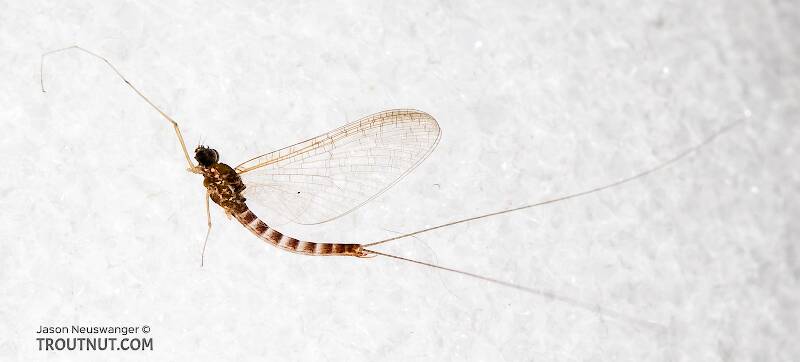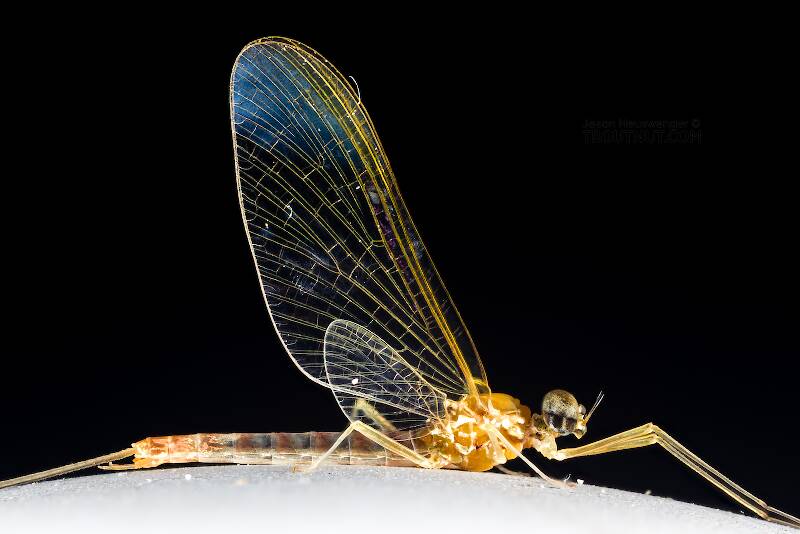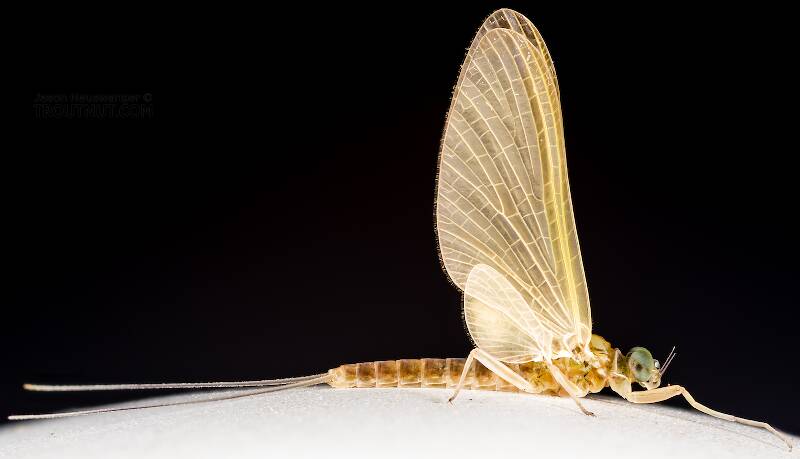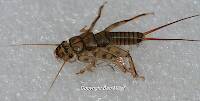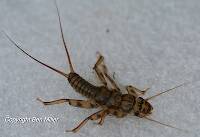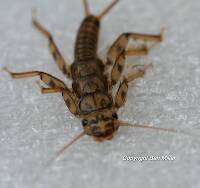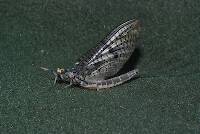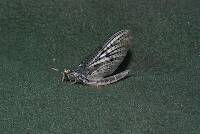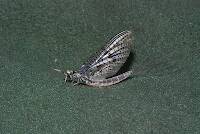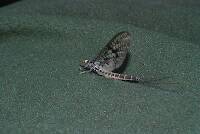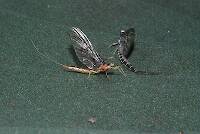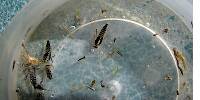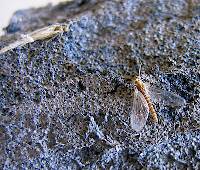
Hex Mayflies
Hexagenia limbata
The famous nocturnal Hex hatch of the Midwest (and a few other lucky locations) stirs to the surface mythically large brown trout that only touch streamers for the rest of the year.
Featured on the forum

This dun emerged from a mature nymph on my desk. Unfortunately its wings didn't perfectly dry out.

Troutnut is a project started in 2003 by salmonid ecologist Jason "Troutnut" Neuswanger to help anglers and
fly tyers unabashedly embrace the entomological side of the sport. Learn more about Troutnut or
support the project for an enhanced experience here.
This topic is about the Mayfly Genus Cinygmula
This is primarily a Western genus. Cinygmula ramaleyi is the most important species, producing good hatches in the West. Cinygmula reticulata may also be relevant, and I have seen a great spinner swarm from an unsung species, Cinygmula par, in the Washington Cascades.There is only one Eastern species, Cinygmula subaequalis, and its importance is minor.
Example specimens
GONZO on Jul 19, 2011July 19th, 2011, 4:15 am EDT
The gills and protruding mouthparts make me think that this might be Cinygmula. I've seen red phase Rhithrogena nymphs, but have never seen this coloration in Cinygmula (or Heptagenia).
PaulRoberts on Jul 19, 2011July 19th, 2011, 7:33 am EDT
I have an image (transparency) of a fully red Heptageniid from a trib of the East Branch Owego Creek in central NY. I keyed it to Heptagenia (now Leucrocruta?) -hebe I believe it was. Narrow rear gills if I remember right.
A friend, and experienced FF, once described an emergence on the Delaware in which a clinger type mayfly he believed to be an Epeorus had a "fire engine red" exuvia. They tied a suplhur-colored emerger with a red yarn shuck to cover it. He never saw it again though. At the time I wondered if it was Rhithrogena sanguinea, but I think they only have red gills. And I've seen Epeorus develop some red in their gills while in an aquarium apparently in response to low 02. But he said the entire shuck was bright red.
Then I found this little all bright red (color of arterial blood) Hepta/Leucro amongst many regular grayish ones. Will post when I can clear the time.
A friend, and experienced FF, once described an emergence on the Delaware in which a clinger type mayfly he believed to be an Epeorus had a "fire engine red" exuvia. They tied a suplhur-colored emerger with a red yarn shuck to cover it. He never saw it again though. At the time I wondered if it was Rhithrogena sanguinea, but I think they only have red gills. And I've seen Epeorus develop some red in their gills while in an aquarium apparently in response to low 02. But he said the entire shuck was bright red.
Then I found this little all bright red (color of arterial blood) Hepta/Leucro amongst many regular grayish ones. Will post when I can clear the time.
GONZO on Jul 19, 2011July 19th, 2011, 7:51 am EDT
I'm eager to see those photos, Paul. Rhithrogena sanguinea is now a synonym of R. impersonata, and the red phase seems to be pretty common in both Eastern and Western species of that genus. They can be all red, as opposed to just the gills. If my suspicion that this is Cinygmula is correct, it would just be an indication that other heptageniids have a red phase.
PaulRoberts on Jul 19, 2011July 19th, 2011, 9:00 am EDT
Nifty.
I've got SO much on my plate, but I'll get it done. It's transparency I'll have to digitize via camera.
I've got SO much on my plate, but I'll get it done. It's transparency I'll have to digitize via camera.
Entoman on Jul 19, 2011July 19th, 2011, 9:04 am EDT
Paul & Lloyd -
This is predominantly a western genus. Cinygmula subaequalis is the only species I'm aware of with an eastern distribution. The maxillary palpi protruding at the sides of the head are the giveaway. The gills are similar looking to Heptagenia, but a close inspection under magnification will show that they lack the fibrilliform portion on gills 2 through 6. Common western species are typically brownish though ramaleyi can have a reddish cast to them similar to this specimen in some watersheds I've sampled. Other species are noted for red gilling as well. This one looks to be fairly immature so perhaps the coloration modifies a little with maturity?
Paul - Critters in your neck of the woods that are easy to confuse with Heptagenia are species of Cinygma - because of similar gilling and the lack of knobs on the sides of the head. They are pretty good sized (up to #8 when mature) and they are usually found only in small headwater creeks (the kind you can usually step across).
Regards,
Kurt
This is predominantly a western genus. Cinygmula subaequalis is the only species I'm aware of with an eastern distribution. The maxillary palpi protruding at the sides of the head are the giveaway. The gills are similar looking to Heptagenia, but a close inspection under magnification will show that they lack the fibrilliform portion on gills 2 through 6. Common western species are typically brownish though ramaleyi can have a reddish cast to them similar to this specimen in some watersheds I've sampled. Other species are noted for red gilling as well. This one looks to be fairly immature so perhaps the coloration modifies a little with maturity?
Paul - Critters in your neck of the woods that are easy to confuse with Heptagenia are species of Cinygma - because of similar gilling and the lack of knobs on the sides of the head. They are pretty good sized (up to #8 when mature) and they are usually found only in small headwater creeks (the kind you can usually step across).
Regards,
Kurt
"It's not that I find fishing so important, it's just that I find all other endeavors of Man equally unimportant... And not nearly as much fun!" Robert Traver, Anatomy of a Fisherman
PaulRoberts on Jul 19, 2011July 19th, 2011, 10:03 am EDT
UGH! Now you've got me curious, Kurt.
PaulRoberts on Jul 19, 2011July 19th, 2011, 2:00 pm EDT
GONZO on Jul 19, 2011July 19th, 2011, 3:25 pm EDT
Thanks for posting these, Paul. It would seem that red Cinygmula nymphs are not uncommon.
Troutnut on Jul 19, 2011July 19th, 2011, 3:39 pm EDT
I've found red Heptageniid nymphs in Wisconsin, New York, and Alaska. At least some are Cinygmula in NY and AK. I would really like to know what causes this condition... maybe something analogous to albinism that's especially common in the Heptageniidae family?
Jason Neuswanger, Ph.D.
Troutnut and salmonid ecologist
Troutnut and salmonid ecologist
PaulRoberts on Jul 19, 2011July 19th, 2011, 6:53 pm EDT
I believe in other animals, like all red toads I've read about, red is a pigment that is mixed with other pigments on normal individuals. Some mutants are simply missing the other pigments. The lack of other markings would be consistent with this idea.
Also, I wonder, is it albinism (EDIT: in those albino Heptageniids you've seen), or just molting individuals?
Also, I wonder, is it albinism (EDIT: in those albino Heptageniids you've seen), or just molting individuals?
Troutnut on Jul 19, 2011July 19th, 2011, 7:01 pm EDT
I'm not sure, but I've wondered about molting and it doesn't seem like that's what's going on. Molted individuals are usually more of a pale blond color, but I've never seen red on them. When I find a red individual in the sample, it tends to stay that way for as long as I have it.
Jason Neuswanger, Ph.D.
Troutnut and salmonid ecologist
Troutnut and salmonid ecologist
Entoman on Jul 19, 2011July 19th, 2011, 7:05 pm EDT
Hi Paul,
Great photos of the Cinygmula nymphs. The top two are subaequalis and the last one is probably mimus.
Jason - I doubt it's an albinism kind of thing (by which I assume you mean a genetic aberration) because there are often too many of them in samples when you do find them. I've only seen it in two genera that also happen to be the only two where unicolorous nymphs are common, at least in my experience. Coincidence?
Regards,
Kurt
Great photos of the Cinygmula nymphs. The top two are subaequalis and the last one is probably mimus.
Jason - I doubt it's an albinism kind of thing (by which I assume you mean a genetic aberration) because there are often too many of them in samples when you do find them. I've only seen it in two genera that also happen to be the only two where unicolorous nymphs are common, at least in my experience. Coincidence?
Regards,
Kurt
"It's not that I find fishing so important, it's just that I find all other endeavors of Man equally unimportant... And not nearly as much fun!" Robert Traver, Anatomy of a Fisherman
PaulRoberts on Jul 19, 2011July 19th, 2011, 7:11 pm EDT
I'm not sure, but I've wondered about molting and it doesn't seem like that's what's going on. Molted individuals are usually more of a pale blond color, but I've never seen red on them. When I find a red individual in the sample, it tends to stay that way for as long as I have it.
I meant your comment that "albinism" is common in Heptageniids. That may be so. I was just wondering if instead of albinism that those "white nymphs" aren't molting -as is seen in crayfish that are very pale (creamy) and unmarked when they first molt ("softshells"), then darken as they "harden".
I see enough nearly white golden stones that I regularly fish an off-white stonefly nymph pattern, esp during spates. I always assumed they were molting individuals.
Entoman on Jul 19, 2011July 19th, 2011, 9:52 pm EDT
Paul -
I know you were just using broad descriptive language, but for those readers that may be confused, technically those aren't protruding mandibles, they're palpi which are entirely different parts.
Paul & Jason - I agree that the red color doesn't seem to be a molting issue, nor is it camouflage related (as some ephemerellids are wont to do in blending with their surroundings). Paul, were your two subaequalis specimens captered on the same date at the same spot? The reason I ask is because I'm wondering perhaps a recessive gene? It seems that every year or two a couple of black phase red squirrels show up in my neighborhood (great nymph dubbing:)).
Regards,
Kurt
I'm surprised I didn't see the protruding mandible before...
I know you were just using broad descriptive language, but for those readers that may be confused, technically those aren't protruding mandibles, they're palpi which are entirely different parts.
Paul & Jason - I agree that the red color doesn't seem to be a molting issue, nor is it camouflage related (as some ephemerellids are wont to do in blending with their surroundings). Paul, were your two subaequalis specimens captered on the same date at the same spot? The reason I ask is because I'm wondering perhaps a recessive gene? It seems that every year or two a couple of black phase red squirrels show up in my neighborhood (great nymph dubbing:)).
Regards,
Kurt
"It's not that I find fishing so important, it's just that I find all other endeavors of Man equally unimportant... And not nearly as much fun!" Robert Traver, Anatomy of a Fisherman
Konchu on Jul 20, 2011July 20th, 2011, 4:19 am EDT
this red might be a chemistry issue. some Baetidae can be green or blue like this.
Entoman on Jul 20, 2011July 20th, 2011, 10:23 am EDT
Hi Luke,
That's why I asked Paul if his specimens were from the same spot and date. It would seem to me if the specimens were all of a particular shade it would be environmental. If they are mixed in the same location and date, perhaps genetic? That's what I was thinking anyway.
Regards,
Kurt
That's why I asked Paul if his specimens were from the same spot and date. It would seem to me if the specimens were all of a particular shade it would be environmental. If they are mixed in the same location and date, perhaps genetic? That's what I was thinking anyway.
Regards,
Kurt
"It's not that I find fishing so important, it's just that I find all other endeavors of Man equally unimportant... And not nearly as much fun!" Robert Traver, Anatomy of a Fisherman
PaulRoberts on Jul 20, 2011July 20th, 2011, 3:58 pm EDT
Same place and if not the same date, very close.
Again, I'm going to guess that this red, with no other markings, is the loss of the other pigments via mutation. Here's an interesting story:
I was at a research lab on the Atlantic coast and one aquaculture project they were working on was the feasibility of raising lobsters for market. They discovered that 1 in say 1000 lobsters were born bright blue. (This happens in some crayfish too). Blue lobsters are something like one in a million in the wild however. Turns out they are a quite common color but the researchers theorize that the blue ones are selected out by predators (sculpins/sea robins and striped bass mostly) and nearly all lobsters are found in the usual earth tones -full mix of pigments. In the lab no such selective pressure exists, and blue lobsters are much more common.
I had thought about this in terms of the red nymph above. The particular collection site is a small trib you can jump over in places. It has a somewhat meager popn of brook trout. It has lots of fast shallows that do not support brookie feeding lies. My guess was that possibly red nymphs are more apt to survive predation in smaller low order streams that offer reduced predation by predators with color vision -fish -esp sculpins, dace, and trout. This might describe certain Heptageniid habitats (?) and explain why they tend to produce red individuals in samplings. (Dunno how red R. impersonata fit into this scenario, if at all, as I don't know their habitat, or anti-predator "strategies" -if anyone does).
And...this may not pan out for the high order stream mayflies either as I have no idea how stiff predatory selection by fish is on these Heptageniids. What are their anti-predation strategies and do they jive with this model? I dunno. Maybe it's simply a relatively low frequency mutation, or suffers attrition for some other reason. Just some interesting conjecture.
Again, I'm going to guess that this red, with no other markings, is the loss of the other pigments via mutation. Here's an interesting story:
I was at a research lab on the Atlantic coast and one aquaculture project they were working on was the feasibility of raising lobsters for market. They discovered that 1 in say 1000 lobsters were born bright blue. (This happens in some crayfish too). Blue lobsters are something like one in a million in the wild however. Turns out they are a quite common color but the researchers theorize that the blue ones are selected out by predators (sculpins/sea robins and striped bass mostly) and nearly all lobsters are found in the usual earth tones -full mix of pigments. In the lab no such selective pressure exists, and blue lobsters are much more common.
I had thought about this in terms of the red nymph above. The particular collection site is a small trib you can jump over in places. It has a somewhat meager popn of brook trout. It has lots of fast shallows that do not support brookie feeding lies. My guess was that possibly red nymphs are more apt to survive predation in smaller low order streams that offer reduced predation by predators with color vision -fish -esp sculpins, dace, and trout. This might describe certain Heptageniid habitats (?) and explain why they tend to produce red individuals in samplings. (Dunno how red R. impersonata fit into this scenario, if at all, as I don't know their habitat, or anti-predator "strategies" -if anyone does).
And...this may not pan out for the high order stream mayflies either as I have no idea how stiff predatory selection by fish is on these Heptageniids. What are their anti-predation strategies and do they jive with this model? I dunno. Maybe it's simply a relatively low frequency mutation, or suffers attrition for some other reason. Just some interesting conjecture.
PaulRoberts on Jul 20, 2011July 20th, 2011, 4:13 pm EDT
Paul -
I'm surprised I didn't see the protruding mandible before...
I know you were just using broad descriptive language, but for those readers that may be confused, technically those aren't protruding mandibles, they're palpi which are entirely different parts.
Sorry...I'm truly rusty and just flying by gestalt lately. So pressed for time. Just No time to look things up lately: femurs, palps, McCaffertium, ... lotsa holes for you guys to fill. At least I won't lead anyone too far astray with you guys so able to pick up after me.
I welcome the scholarly input. Makes this site a true reference, setting it apart from other fishing related sites. I can stand the heat, and appreciate the depth of knowledge and development of this site.
Entoman on Jul 20, 2011July 20th, 2011, 7:13 pm EDT
Thanks Paul - When it comes to bugs, I'm just a self educated fisherman and the last guy that should be nit-picky. Anyway, I agree with you on the mutant or latent gene being the probable cause. If it were invironmental, you'd think the coloration would be more across the board at a given locale.
Best regards,
Kurt
Best regards,
Kurt
"It's not that I find fishing so important, it's just that I find all other endeavors of Man equally unimportant... And not nearly as much fun!" Robert Traver, Anatomy of a Fisherman
GONZO on Jul 20, 2011July 20th, 2011, 9:39 pm EDT
Just for giggles, I've been reading Ide's original 1954 description of Rhithrogena sanguinea (now R. impersonata). Although he considered the red form to be a separate species and perhaps an example of "sympatric speciation," his observations are interesting. He said that the red form ("sanguinea") was found in the same habitat, often occupying the same rock, and it emerged at the same time and mated in the same swarms as R. impersonata. He also noted (and illustrated) that the genitalia are basically identical. All of this makes sense, given the synonymy.
Although an anecdotal observation, he claimed that he extracted 13 mating pairs from a swarm: 12 were a male impersonata with a female impersonata, and the 13th was a male "sanguinea" with a female "sanguinea." He also mentioned that he found two male impersonata trying to mate with other genera/species; one with a female Ephemerella excrucians and the other with a female Siphlonurus rapidus.
He speculated that the red color seemed to have a parallel in the pale green pigment that he saw in impersonata:
He also mentioned that the red color can be found in R. doddsi (now synonymous with R. hageni) and in R. rubicunda.
Although an anecdotal observation, he claimed that he extracted 13 mating pairs from a swarm: 12 were a male impersonata with a female impersonata, and the 13th was a male "sanguinea" with a female "sanguinea." He also mentioned that he found two male impersonata trying to mate with other genera/species; one with a female Ephemerella excrucians and the other with a female Siphlonurus rapidus.
He speculated that the red color seemed to have a parallel in the pale green pigment that he saw in impersonata:
Living individuals of R. impersonata have a decidedly greenish tinge which is most noticeable in the areas which are red in R. sanguinea but this is lost in the dried specimens and probably also in specimens in alcohol. It seems probable that the red pigment of one species and the green of the other are related biochemical substances. It is possible that they have some significance in respiration. The distribution of the two pigments in a similar manner in parts of the body having a thinner cuticle and the fact that the pigment carries through from the nymph and subimago to the imago suggests that it is a blood or muscle pigment rather than part of the external colour pattern.
He also mentioned that the red color can be found in R. doddsi (now synonymous with R. hageni) and in R. rubicunda.
Quick Reply
Related Discussions
Topic
Replies
Last Reply
12
Mar 28, 2013
by Brookyman
by Brookyman
9
Apr 29, 2009
by Taxon
by Taxon
2
Feb 6, 2017
by Crepuscular
by Crepuscular


